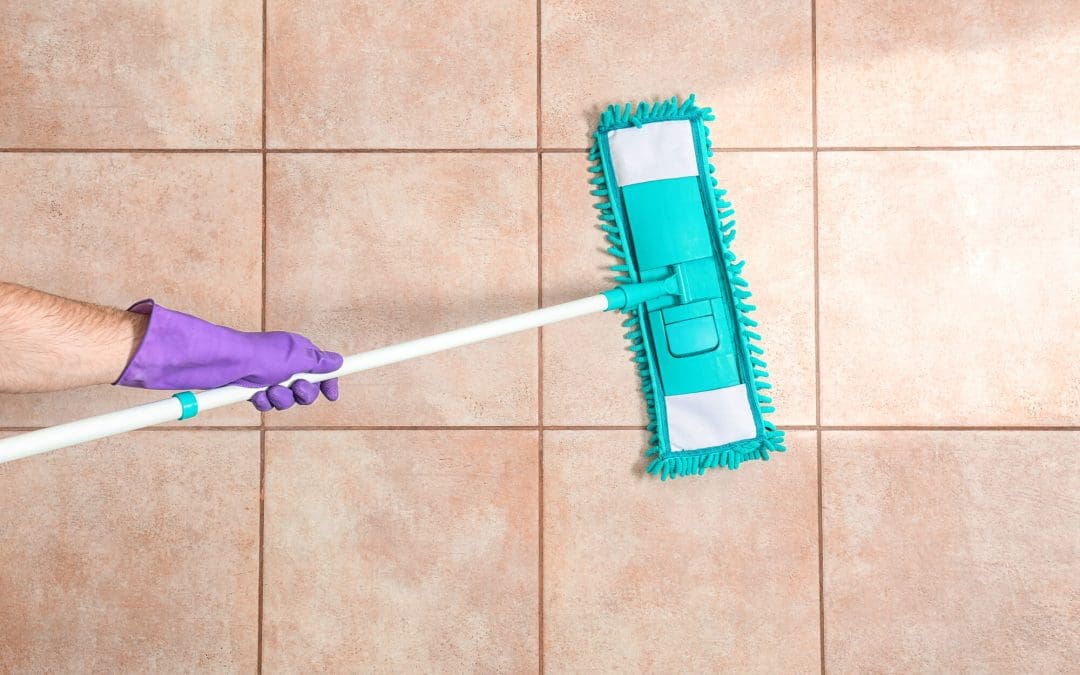Tile flooring is one of the most popular choices for homeowners due to its durability, aesthetic appeal, and easy maintenance. However, keeping your tile floors clean and free of grime requires more than just a quick sweep. Whether you have ceramic, porcelain, or natural stone tiles, here are some tips for cleaning tile flooring correctly.
Understanding Your Tile Type
Before you begin cleaning, it’s essential to know what type of tile you have. The most common types are ceramic, porcelain, and natural stone.
- Ceramic tiles: Known for their hard surface and glazed finish, ceramic tiles are relatively easy to clean and maintain.
- Porcelain tiles: These are a more durable, denser option that can handle heavier foot traffic.
- Natural stone tiles: These include options like marble, granite, and slate, which require special care due to their porous nature.
Understanding your tile type is crucial for choosing the right cleaning products and methods, as not all cleaners are suitable for every tile type.
Preparing the Surface Before Cleaning Tile Flooring
The first step to cleaning any tile floor is to remove loose dirt and debris. Dust, sand, and small particles can cause scratches, especially on natural stone tiles. Start by sweeping the floor using a soft-bristled broom, paying particular attention to corners and high-traffic areas. You can also use a vacuum cleaner, but make sure it is designed for hard floors to prevent scratching the tiles.
Mopping for Daily Maintenance
Mopping your tile floors regularly helps maintain their shine and removes dirt that sweeping alone can’t. For most tile types, a damp mop with warm water is enough for daily cleaning. However, avoid soaking the floors with too much water, especially for natural stone tiles, as water can seep into the grout and cause damage over time.
For a deeper clean, use a pH-balanced tile cleaner or a mild dish soap diluted in water. Wring out the mop thoroughly before cleaning to avoid leaving excess water on the floor. After mopping, go over the surface with a clean, dry mop or towel to remove moisture and prevent streaking.
Tackling Grout Stains
Grout can often be the culprit behind dingy-looking tile floors. Over time, grout can become stained from dirt, spills, and foot traffic. You’ll need a specialized cleaner or a DIY mixture of baking soda and water to clean the grout effectively. Apply the cleaner directly to the grout lines and let it sit for 5–10 minutes before scrubbing with a small brush or old toothbrush.
After scrubbing, wipe down the area with a damp cloth to remove any remaining residue. For stubborn grout stains, you may need to repeat the process or consider using a steam cleaner to penetrate deep into the grout and remove built-up grime.
Cleaning Natural Stone Tiles
Natural stone tiles, like marble and granite, require more delicate care than ceramic or porcelain tiles. Avoid using acidic cleaners such as vinegar or lemon juice, as they can etch the stone’s surface. Instead, opt for a pH-neutral cleaner specifically designed for natural stone.
After cleaning, it’s a good idea to seal your natural stone tiles to protect them from future stains and spills. Sealing should be done at least once a year or more frequently in high-traffic areas. Follow the manufacturer’s instructions when applying the sealant, and avoid walking on the floor until it is completely dry.
Removing Tough Stains and Scuffs While Cleaning Tile Flooring
For tough stains on ceramic or porcelain tiles, try using a non-abrasive cleaner like a paste made from baking soda and water. Apply the paste to the stain, let it sit for a few minutes, and then scrub gently with a sponge or soft cloth. Rinse the area thoroughly with water and dry it with a clean towel to avoid water spots.
Scuff marks from shoes or furniture can be easily removed with a pencil eraser or a cloth dampened with a bit of dish soap. For stubborn marks, a magic eraser works wonders without damaging the tile surface.
Drying and Buffing for a Streak-Free Shine
After mopping or cleaning any stains, always dry your tile flooring thoroughly. This prevents streaks and helps to avoid water spots. Use a clean, dry microfiber cloth or towel to buff the floor to a shine.
For an extra layer of polish, you can apply a commercial tile floor polish designed for your specific tile type. These polishes help enhance the natural beauty of the tiles and provide an additional protective layer against dirt and stains.
Regular Maintenance Tips For Cleaning Tile Flooring
Consistency is key to maintaining clean tile flooring. In high-traffic areas, sweeping or vacuuming daily and mopping weekly can keep your floors looking fresh. You can reduce the cleaning frequency for less frequented areas, but always keep an eye on spills or dirt buildup.
Consider placing floor mats at entrances to reduce the amount of dirt and debris that gets tracked onto your tile floors. Mats can significantly reduce the cleaning you’ll need to do in the long run.
Keeping your tile flooring clean doesn’t have to be a chore if you stick to a regular maintenance routine and use the right cleaning methods for your specific tile type. With the right tools and products, you can maintain the beauty and longevity of your tile floors, ensuring they look their best for years to come. Following these steps will protect your tile flooring against wear and tear.
FAQs
Can I use homemade cleaners on my tile floors?
Yes, homemade cleaners can be effective and eco-friendly. A popular solution is a mixture of warm water and baking soda, which works well for removing stains and grime. You can also mix rubbing alcohol, water, and a few drops of dish soap for an effective cleaner. However, always test any DIY cleaner on a small, inconspicuous area first to ensure it won’t harm your tiles.
2. How do I clean textured or non-slip tiles?
Textured tiles can trap more dirt than smooth tiles. You may need to scrub these more frequently with a soft brush or a microfiber mop. Use a gentle cleaner and apply a little extra pressure to get into the crevices of the texture. Avoid using too much water, which can settle into the grout lines.
Is it safe to use abrasive tools to scrub tough stains?
It’s tempting to use abrasive tools like steel wool for tough stains, but these can scratch the surface of your tiles, especially glossy or polished ones. Instead, opt for a soft-bristled brush or a nylon scrub pad. If you need more scrubbing power, consider using a paste of baking soda and water to safely lift the stain without damaging the tile.
What’s the best way to deal with mold or mildew on tile and grout?
Mold and mildew are common in bathrooms or humid areas. To tackle them, use a solution of hydrogen peroxide and water or a commercial mold and mildew remover. Apply the solution directly to the affected area and scrub with a stiff brush. Avoid using acidic cleaners if you have natural stone tiles, as they can harm the stone. Ensure the area is dried completely after cleaning to prevent regrowth.
Jamie Schaefer, Professional Home Inspector, provides inspection services to The Villages, Florida, and the surrounding cities and towns in Central Florida and the New York Metropolitan Area. If you’re buying or selling a property, contact us to request an appointment.

